radis.lbl.base module¶
Summary¶
A class to aggregate methods to calculate spectroscopic parameter and populations (and unload factory.py)
BaseFactory is inherited by
BroadenFactory eventually
Routine Listing¶
PUBLIC METHODS
radis.lbl.base.BaseFactory.print_conditions()>>> get all calculation conditionsradis.lbl.base.BaseFactory.get_energy_levels()>>> return energy databaseradis.lbl.base.BaseFactory.plot_linestrength_hist()>>> plot distribution of linestrengths
PRIVATE METHODS - CALCULATE SPECTROSCOPIC PARAMETERS (everything that doesnt depend on populations / temperatures) (computation: work & update with ‘df0’ and called before eq_spectrum() )
radis.lbl.base.BaseFactory._add_EvibErot()radis.lbl.base.BaseFactory._add_EvibErot_CDSD()radis.lbl.base.BaseFactory._add_EvibErot_RADIS_cls1()radis.lbl.base.BaseFactory._add_Evib123Erot_RADIS_cls5()radis.lbl.base.BaseFactory._add_ju()radis.lbl.base.BaseFactory._add_Eu()radis.lbl.base.BaseFactory._calc_noneq_parameters()
PRIVATE METHODS - APPLY ENVIRONMENT PARAMETERS (all functions that depends upon T or P) (calculates populations, linestrength & radiance, lineshift) (computation: work on df1, called by or after eq_spectrum() )
radis.lbl.base.BaseFactory._cutoff_linestrength()
Most methods are written in inherited class with the following inheritance scheme:
DatabankLoader > BaseFactory >
BroadenFactory > BandFactory >
SpectrumFactory

- class BaseFactory[source]¶
Bases:
DatabankLoader- Qgas(df1, Tgas)[source]¶
Calculate partition function Qgas at temperature
Tgas, for all lines ofdf1. Returns a single value if all lines have the same Qgas value, or a column if they are different- Parameters
Tgas (float (K)) – gas temperature
- Returns
float or dict
- Return type
Returns Qgas as a dictionary with isotope values as its keys
See also
Qgas_Qref_ratio()
- Qneq(df, Tvib, Trot, vib_distribution, rot_distribution, overpopulation)[source]¶
Nonequilibrium partition function
- Returns
column or float
- Return type
depending if there are many isotopes or one
- Qneq_Qvib_Qrotu_Qrotl(df, Tvib, Trot, vib_distribution, rot_distribution, overpopulation)[source]¶
Nonequilibrium partition function; with the detail of vibrational partition function and rotational partition functions
- Qref_Qgas_ratio(df1, Tgas, Tref)[source]¶
Calculate Qref/Qgas at temperature
Tgas,Tref, for all lines ofdf1. Returns a single value if all lines have the same Qref/Qgas ratio, or a column if they are differentSee also
- assert_no_nan(df, column)[source]¶
Assert there are no nan in the column.
Crash with a nice explanation if one is found
- calc_S0()[source]¶
Calculate the unscaled intensity from the tabulated Einstein coefficient.
- Parameters
None
- Returns
None
- Return type
self.df0is updated directly with new columnS0
References
\[S_0 = \frac{I_a g' A_{21}}{8 \pi c \nu^2}\]Notes
Currently this value is only used in GPU calculations. It is one of the columns that is transferred to the GPU memory. The idea behind S0 is that it is scaled with all variabled that do not change during iterations as to minimize calculations.
Units: cm-1/(molecules/cm-2
- NOTE: S0 is not directly related to S(T) used elsewhere!!!
(It may even differ in units!!!)
- calc_einstein_coefficients()[source]¶
Calculate \(A_{ul}\), \(B_{lu}\), \(B_{ul}\) Einstein coefficients from weighted transition moments squared \(R_s^2\).
- Returns
None
- Return type
self.df0is updated directly with new columnsAul,Blu,Bul
Notes
Einstein A coefficient already in database under df0.A Difference between df0.A and df0.Aul < 0.5%
References
Einstein induced absorption coefficient (in \(cm^3/J/s^2\))
\[B_{lu}=10^{-36}\cdot\frac{8{\pi}^3}{3h^2} R_s^2 \cdot 10^{-7}\]Einstein induced emission coefficient (in \(cm^3/J/s^2\))
\[B_{ul}=10^{-36}\cdot\frac{8{\pi}^3}{3h^2} \frac{gl}{gu} R_s^2 \cdot 10^{-7}\]Einstein spontaneous emission coefficient (in \(s^{-1}\))
\[A_{ul}=10^{-36}\cdot\frac{\frac{64{\pi}^4}{3h} {\nu}^3 gl}{gu} R_s^2\]See (Eqs.(A7), (A8), (A9) in [Rothman-1998])
- calc_emission_integral()[source]¶
Calculate the emission integral (in \(mW/sr\)) of all lines in DataFrame
df1.\[E_i=\frac{n_u A_{ul}}{4 \pi} \Delta E_{ul}\]Where \(A_{ul}\) (\(s^{-1}\)) is the Einstein coefficient of the corresponding line, \(n_u\) (in \(cm^{-3}/cm^{-3}\) is the fraction of the molecule population in the upper rovibrational state, and \(\Delta E_{ul}\) the transition energy.
Emission Integral is a non usual quantity introduced in RADIS as an equivalent for emission calculations of the Linestrength quantity used in absorption calculations.
The emission integral is later multiplied by the total density \(n_tot\) and the lineshape \(\Phi_i\) to obtain the spectral emission coefficient \(\epsilon_i\) associated to each line.
\[\epsilon_i(\lambda) = E_i \cdot n_{tot} \cdot \Phi_i(\lambda)\]Which are afterwards summed over all N lines to obtain the total emission coefficient :
\[\epsilon(\lambda) = \sum_i^N {\epsilon_i}(\lambda)\]- Returns
Emission integral
Eiadded indf1- Return type
None
See also
- calc_lineshift()[source]¶
Calculate lineshift due to pressure.
- Returns
None
- Return type
self.df1is updated directly with new columnshiftwav
References
Shifted line center based on pressure shift coefficient \(lambda_{shift}\) and pressure \(P\).
\[\omega_{shift}=\omega_0+\lambda_{shift} P\]See Eq.(A13) in [Rothman-1998]
- calc_linestrength_eq(Tgas)[source]¶
Calculate linestrength at temperature Tgas correcting the database linestrength tabulated at temperature \(T_{ref}\).
- Parameters
Tgas (float (K)) – gas temperature
- Returns
None
- Return type
self.df1is updated directly with new columnS
References
\[S(T) = S_0 \frac{Q_{ref}}{Q_{gas}} \operatorname{exp}\left(-E_l \left(\frac{1}{T_{gas}}-\frac{1}{T_{ref}}\right)\right) \frac{1-\operatorname{exp}\left(\frac{-\omega_0}{Tgas}\right)}{1-\operatorname{exp}\left(\frac{-\omega_0}{T_{ref}}\right)}\]See Eq.(A11) in [Rothman-1998]
Notes
Internals:
(some more informations about what this function does)
Starts with df1 which is still a copy of df0 loaded by
load_databank()Updates linestrength in df1. Cutoff criteria is applied afterwards.See also
- calc_linestrength_noneq()[source]¶
Calculate linestrengths at non-LTE
- Parameters
Pre-requisite – lower state population
nlhas already been calculated bycalc_populations_noneq()- Returns
Linestrength
Sadded in self.df- Return type
None
Notes
Internals:
(some more informations about what this function does)
Starts with df1 which is was a copy of df0 loaded by load_databank(), with non-equilibrium quantities added and populations already calculated. Updates linestrength in df1. Cutoff criteria is applied afterwards.
- calc_populations_eq(Tgas)[source]¶
Calculate upper state population for all active transitions in equilibrium case (only used in total power calculation)
- Parameters
Tgas (float (K)) – temperature
- Returns
nuis stored in self.df1- Return type
None
Notes
Isotopes: these populations are not corrected for the isotopic abundance, i.e, abundance has to be accounted for if used for emission density calculations (based on Einstein A coefficient), but not for linestrengths (that include the abundance dependency already)
References
Population of upper state follows a Boltzmann distribution:
\[n_u = g_u \frac{\operatorname{exp}\left(\frac{-E_u}{T_{gas}}\right)}{Q_{gas}}\]See also
calc_populations_noneq(),_calc_populations_noneq_multiTvib(),at()
- calc_populations_noneq(Tvib, Trot, vib_distribution='boltzmann', rot_distribution='boltzmann', overpopulation=None)[source]¶
Calculate upper and lower state population for all active transitions, as well as all levels (through
at_noneq())- Parameters
Tvib, Trot (float (K)) – temperatures
vib_distribution (
'boltzmann','treanor') – vibrational level distributionrot_distribution (
'boltzmann') – rotational level distributionoverpopulation (dict, or
None) – dictionary of overpopulation factors for vibrational levels
- Returns
None
- Return type
nu,nl,nu_vib,nl_vibare stored in self.df1
Notes
Isotopic abundance:
Note that these populations are not corrected for the isotopic abundance, i.e, abundance has to be accounted for if used for emission density calculations (based on Einstein A coefficient), but not for linestrengths (that include the abundance dependency already)
All populations:
This method calculates populations of emitting and absorbing levels. Populations of all levels (even the one not active on the spectral range considered) are calculated during the Partition function calculation. See:
at_noneq()References
Boltzmann vibrational distributions
\[n_{vib}=\frac{g_{vib}}{Q_{vib}} \operatorname{exp}\left(\frac{-E_{vib}}{T_{vib}}\right)\]or Treanor vibrational distributions
\[n_{vib}=\frac{g_{vib}}{Qvib} \operatorname{exp}\left(-\left(\frac{E_{vib,harm}}{T_{vib}}+\frac{E_{vib,anharm}}{T_{rot}}\right)\right)\]Overpopulation of vibrational levels
\[n_{vib}=\alpha n_{vib}\]Boltzmann rotational distributions
\[n_{rot}=\frac{g_{rot}}{Q_{rot}} \operatorname{exp}\left(\frac{-E_{rot}}{T_{rot}}\right)\]Final rovibrational population of one level
\[n=n_{vib} n_{rot} \frac{Q_{rot} Q_{vib}}{Q}\]See also
calc_populations_eq(),_calc_populations_noneq_multiTvib(),at_noneq()
- calc_weighted_trans_moment()[source]¶
Calculate weighted transition-moment squared \(R_s^2\) (in
Debye^2)- Returns
self.df0is updated directly with new columnRs2. R is inDebye^2(1e-36 ergs.cm3)- Return type
None
References
Weighted transition-moment squared \(R_s^2\) from linestrength \(S_0\) at temperature \(T_ref\), derived from Eq.(A5) in [Rothman-1998]
- cond_units = {'Tgas': 'K', 'Tref': 'K', 'Trot': 'K', 'Tvib': 'K', 'calculation_time': 's', 'cutoff': 'cm-1/(#.cm-2)', 'neighbour_lines': 'cm-1', 'path_length': 'cm', 'pressure_mbar': 'mbar', 'truncation': 'cm-1', 'wavelength_max': 'nm', 'wavelength_min': 'nm', 'wavenum_max': 'cm-1', 'wavenum_max_calc': 'cm-1', 'wavenum_min': 'cm-1', 'wavenum_min_calc': 'cm-1', 'wstep': 'cm-1'}[source]¶
Calculation Conditions units
- get_energy_levels(molecule, isotope, state='X', conditions=None)[source]¶
Return energy levels database for given molecule > isotope > state (look up Factory.parsum_calc[molecule][iso][state])
- Parameters
molecule (str) – molecule name
isotope (int) – isotope identifier
state (str:) – electronic state. Default
'X'(ground-state)conditions (str, or
None) – if not None, add conditions on which energies to retrieve, e.g:>>> 'j==0' or 'v1==0'
Conditions are applied using Dataframe.query() method. In that case,
get_energy_levels()returns a copy. DefaultNone
- Returns
energies – a view of the energies stored in the Partition Function calculator for isotope iso. If conditions are applied, we get a copy
- Return type
pandas Dataframe
See also
- get_lines_abundance(df)[source]¶
Returns the isotopic abundance of each line in
df- Parameters
df (dataframe)
- Returns
float or dict
- Return type
The abundance of all the isotopes in the dataframe
- get_molar_mass(df)[source]¶
Returns molar mass for all lines of DataFrame
df.- Parameters
df (pd.DataFrame)
- Return type
The molar mass of all the isotopes in the dataframe
- get_populations(levels='vib')[source]¶
For all molecules / isotopes / electronic states, lookup energy levels as calculated in partition function calculators, and (if calculated) populations, and returns as a dictionary.
- Parameters
levels (
'vib','rovib', list of these, orNone) – what levels to get. Note that'rovib'can yield large Spectrum objects.- Returns
pops –
Structure:
{molecule: {isotope: {electronic_state: {'vib': pandas Dataframe, # (copy of) vib levels 'rovib': pandas Dataframe, # (copy of) rovib levels 'Ia': float # isotopic abundance }}}}
- Return type
dict
See also
- plot_hist(dataframe='df0', what='int', axvline=None)[source]¶
Plot distribution of column
whatindataframeFor instance, help determine a cutoff criteria
plot_hist("df1", "int")
- Parameters
dataframe (‘df0’, ‘df1’) – which dataframe to plot (df0 is the loaded one, df1 the scaled one)
what (str) – which feature to plot. Default
'S'(scaled linestrength). Could also be'int'(reference linestrength intensity),'A'(Einstein coefficient)axvline (float) – if not
None, plot a vertical line at this position.
- plot_linestrength_hist(cutoff=None)[source]¶
Plot linestrength distribution (to help determine a cutoff criteria)
Examples
s, sf = calc_spectrum(..., return_factory=True) sf.plot_linestrength_hist()
- plot_populations(what='vib', isotope=None, nfig=None)[source]¶
Plot populations currently calculated in factory.
Plot populations of all levels that participate in the partition function. Output is different from the Spectrum
plot_populations()method, where only the levels that directly contribute to the spectrum are shownNote: only valid after calculating non_eq spectrum as it uses the partition function calculator object
- Parameters
what (‘vib’, ‘rovib’) – what levels to plot
isotope (int, or
None) – which isotope to plot. IfNoneand if there are more than one isotope, raises an error.
- Other Parameters
nfig (int, or str) – on which Figure to plot. Default
None
- print_conditions(preprend=None)[source]¶
Prints all physical / computational parameters. These are also stored in each result Spectrum.
- Parameters
preprend (str) – just to text to display before printing conditions
- units = {'abscoeff': 'cm-1', 'abscoeff_continuum': 'cm-1', 'absorbance': '', 'emisscoeff': 'mW/cm3/sr/cm-1', 'emisscoeff_continuum': 'mW/cm3/sr/cm-1', 'emissivity_noslit': '', 'radiance_noslit': 'mW/cm2/sr/cm-1', 'transmittance_noslit': '', 'waverange': 'cm-1'}[source]¶
Default output units … may be changed at the initialisation of the SpectrumFactory, for instance … if user gives wavelength units we want to return radiance in … “mW/cm2/sr/nm” units for consistency
- get_wavenumber_range(wmin=None, wmax=None, wunit=cm - 1, wavenum_min=None, wavenum_max=None, wavelength_min=None, wavelength_max=None, medium='air', return_input_wunit=False)[source]¶
Returns wavenumber based on whatever input was given: either ν_min, ν_max directly, or λ_min, λ_max in the given propagation
medium.- Parameters
medium (
'air','vacuum') – propagation mediumwmin, wmax (float, or
QuantityorNone) – hybrid parameters that can serve as both wavenumbers or wavelength depending on the unit accompanying them. If unitless, wunit is assumed as the accompanying unit.wunit (string) – The unit accompanying wmin and wmax. Cannot be passed without passing values for wmin and wmax. Default: cm-1
wavenum_min, wavenum_max (float, or
QuantityorNone) – wavenumberswavelength_min, wavelength_max (float, or
QuantityorNone) – wavelengths in givenmedium
- Returns
wavenum_min, wavenum_max (float) – wavenumbers
input_wunit (‘nm’, ‘nm_vac’, ‘cm-1’) – in which wavespace was the input given before conversion (used to keep default plot/get consistent with input units)
- linestrength_from_Einstein(A, gu, El, Ia, nu, Q, T)[source]¶
Calculate linestrength at temperature
Tfrom Einstein coefficients.- Parameters
A (float, s-1) – Einstein emission coefficients
gu (int) – upper state degeneracy
El (float, cm-1) – lower state energy
Ia (float) – isotope abundance
nu (cm-1) – transition wavenumber
Q (float) – partition function at temperature
TT (float) – temperature
- Returns
S – linestrength at temperature
T.- Return type
float
References
\[S(T) =\frac{1}{8\pi c_{CGS} {n_u}^2} A \frac{I_a g_u \operatorname{exp}\left(\frac{-c_2 E_l}{T}\right)}{Q(T)} \left(1-\operatorname{exp}\left(\frac{-c_2 n_u}{T}\right)\right)\]Combine Eq.(A.5), (A.9) in [Rothman-1998]
See also




